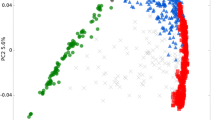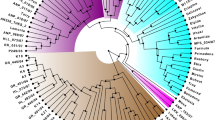Abstract
Tomato (Solanum lycopersicum L.) is an economically important vegetable crop worldwide. Recently, a high-density single nucleotide polymorphism (SNP) array was developed based on genome-wide SNPs in tomato. In this study, we genotyped a collection of 48 Korean elite tomato varieties (26 fresh market and 22 cultivated cherry) using 7,720 SNPs of this array. Out of 6,652 polymorphic SNPs (86.1%) in the entire collection, there were 6,589 SNPs with < 10% missing data. The number of polymorphic SNPs in the fresh market and cultivated cherry subpopulations were 4,733 (61.3%) and 6,087 (78.8%), respectively. To examine the genetic variation between sub-populations, the SNP genotypes of the Korean tomato germplasm were analyzed along with the previously reported data on SNPs of the 277 Solanaceae Agricultural Coordinated Project (SolCAP) varieties (109 fresh market, 27 cultivated cherry, and 141 processing). Principal component analysis, pairwise F st, and Nei’s standard genetic distance revealed genetic differentiation between these five sub-populations. Moreover, we validated another division within the Korean cherry varieties using the unweighted pair group mean algorithm (UPGMA). The genetic diversity of each sub-population was estimated based on allelic richness and expected heterozygosity. The fresh market and cultivated cherry sub-populations in the Korean tomato germplasm showed similar levels of genetic diversity as the corresponding SolCAP sub-populations. Visualization of the polymorphic information revealed genomic regions that differed between the two sub-populations in the Korean tomato germplasm. These results suggest that diversifying selection for market niches and environmental adaptation has led to allelic variation in cultivated tomatoes in Korea.
Similar content being viewed by others
Literature Cited
Agarwal, S. and A.V. Rao. 2000. Tomato lycopene and its role in human health and chronic diseases. Can. Med. Assoc. J. 163:739–744.
Barrantes, W., A. Fernandez-del-Carmen, G. Lopez-Casado, M.A. Gonzalez-Sanchez, R. Fernandez-Munoz, A. Granell, and A.J. Monforte. 2014. Highly efficient genomics-assisted development of a library of introgression lines of Solanum pimpinellifolium. Mol. Breed. 34:1817–1831.
Blanca, J., J. Canizares, L. Cordero, L. Pascual, M.J. Diez, and F. Nuez. 2012. Variation revealed by SNP genotyping and morphology provides insight into the origin of the tomato. PLoS ONE 7:e48198.
Blanca, J., J. Montero-Pau, C. Sauvage, G. Bauchet, E. Illa, M.J. Diez, D. Francis, M. Causse, E. van der Knaap, and J. Canizares. 2015. Genomic variation in tomato, from wild ancestors to contemporary breeding accessions. BMC Genomics 16:257.
Botstein, D., R.L. White, M. Skolnick, and R.W. Davis. 1980. Construction of a genetic linkage map in man using restriction fragment length polymorphisms. Am. J. Hum. Genet. 32:314–331.
Corrado, G., P. Piffanelli, M. Caramante, M. Coppola, and R. Rao. 2013. SNP genotyping reveals genetic diversity between cultivated landraces and contemporary varieties of tomato. BMC Genomics 14:835.
Dieringer, D. and C. Schlotterer. 2003. MICROSATELLITE ANALYSER (MSA): a platform independent analysis tool for large microsatellite data sets. Mol. Ecol. Notes 3:167–169.
El Mousadik, A. and R.J. Petit. 1996. High level of genetic differentiation for allelic richness among populations of the argan tree [Argania spinosa (L) Skeels] endemic to Morocco. Theor. Appl. Genet. 92:832–839.
Gupta, P.K., S. Rustgi, and R.R. Mir. 2008. Array-based high-throughput DNA markers for crop improvement. Heredity 101:5–18.
Hamilton, J.P., S.C. Sim, K. Stoffel, A. Van Deynze, C.R. Buell, and D.M. Francis. 2012. Single nucleotide polymorphism discovery in cultivated tomato via sequencing by synthesis. The Plant Genome 5:17–29.
Hurlbert, S.H. 1971. The nonconcept of species diversity: a critique and alternative parameters. Ecology 52:577–586.
Jiménez-Gómez, J. and J. Maloof. 2009. Sequence diversity in three tomato species: SNPs, markers, and molecular evolution. BMC Plant Biol. 9:85.
Jones, D.A., C.M. Thomas, K.E. Hammondkosack, P.J. Balintkurti, and J.D.G. Jones. 1994. Isolation of the tomato Cf-9 gene for resistance to Cladosporium fulvum by transposon tagging. Science 266:789–793.
Kawchuk, L.M., J. Hachey, D.R. Lynch, F. Kulcsar, G. van Rooijen, D.R. Waterer, A. Robertson, E. Kokko, R. Byers, R.J. Howard, R. Fischer, and D. Prufer. 2001. Tomato Ve disease resistance genes encode cell surface-like receptors. Proc. Natl. Acad. Sci. USA 98:6511–6515.
Krzywinski, M.I., J.E. Schein, I. Birol, J. Connors, R. Gascoyne, D. Horsman, S.J. Jones, and M.A. Marra. 2009. Circos: An information aesthetic for comparative genomics. Genome Res. 19:1639–1645.
Labate, J.A. and A.M. Baldo. 2005. Tomato SNP discovery by EST mining and resequencing. Mol. Breed. 16:343–349.
Labate, J.A., L.D. Robertson, F.N. Wu, S.D. Tanksley, and A.M. Baldo. 2009. EST, COSII, and arbitrary gene markers give similar estimates of nucleotide diversity in cultivated tomato (Solanum lycopersicum L.). Theor. Appl. Genet. 118:1005–1014.
Lin, T., G. Zhu, J. Zhang, X. Xu, Q. Yu, Z. Zheng, Z. Zhang, Y. Lun, S. Li, X. Wang, Z. Huang, J. Li, C. Zhang, T. Wang, Y. Zhang, A. Wang, Y. Zhang, K. Lin, C. Li, G. Xiong, Y. Xue, A. Mazzucato, M. Causse, Z. Fei, J. J. Giovannoni, R. T. Chetelat, D. Zamir, T. Stadler, J. Li, Z. Ye, Y. Du, and S. Huang. 2014. Genomic analyses provide insights into the history of tomato breeding. Nat. Genet. 46:1220–1226.
Martin, G.B., S.H. Brommonschenkel, J. Chunwongse, A. Frary, M.W. Ganal, R. Spivey, T. Wu, E.D. Earle, and S.D. Tanksley. 1993. Map-based cloning of a protein kinase gene conferring disease resistance in tomato. Science 262:1432–1436.
Miller, J.C., and S.D. Tanksley. 1990. RFLP analysis of phylogenetic relationships and genetic variation in the genus Lycopersicon. Theor. Appl. Genet. 80:437–448.
Milligan, S.B., J. Bodeau, J. Yaghoobi, I. Kaloshian, P. Zabel, and V.M. Williamson. 1998. The root knot nematode resistance gene Mi from tomato is a member of the leucine zipper, nucleotide binding, leucine-rich repeat family of plant genes. Plant Cell 10:1307–1319.
Nei, M. 1978. Estimation of average heterozygosity and genetic distance from a small number of individuals. Genetics 89:583–590.
Park, Y.H., M.A.L. West, and D.A. St Clair. 2004. Evaluation of AFLPs for germplasm fingerprinting and assessment of genetic diversity in cultivars of tomato (Lycopersicon esculentum L.). Genome 47:510–518.
Pnueli, L., L. CarmelGoren, D. Hareven, T. Gutfinger, J. Alvarez, M. Ganal, D. Zamir, and E. Lifschitz. 1998. The SELF-PRUNING gene of tomato regulates vegetative to reproductive switching of sympodial meristems and is the ortholog of CEN and TFL1. Development 125:1979–1989.
R Development Core Team. 2011. R: A Language and Environment for Statistical Computing. R Foundation for Statistical Computing, Vienna, Austria.
Rodriguez, G.R., H.J. Kim, and E. van der Knaap. 2013. Mapping of two suppressors of OVATE (sov) loci in tomato. Heredity 111:256–264.
Rohlf, F.J. 2008. NTSYSpc: Numerical taxonomy system, ver. 2.20. Exeter Publishing Ltd., Setauket, NY, USA.
Ronen, G., L. Carmel-Goren, D. Zamir, and J. Hirschberg. 2000. An alternative pathway to beta-carotene formation in plant chromoplasts discovered by map-based cloning of Beta and old-gold color mutations in tomato. Proc. Natl. Acad. Sci. USA 97:11102–11107.
Ruggieri, V., G. Francese, A. Sacco, A. D'Alessandro, M.M. Rigano, M. Parisi, M. Milone, T. Cardi, G. Mennella, and A. Barone. 2014. An association mapping approach to identify favourable alleles for tomato fruit quality breeding. BMC Plant Biol. 14.
Sauvage, C., V. Segura, G. Bauchet, R. Stevens, P.T. Do, Z. Nikoloski, A.R. Fernie, and M. Causse. 2014. Genome-wide association in tomato reveals 44 candidate loci for fruit metabolic traits. Plant Physiol. 165:1120–1132.
Sherman, J.D. and S.M. Stack. 1992. Two-dimensional spreads of synaptonemal complexes from solanaceous plants. 5. Tomato (Lycopersicon esculentum) karyotype and idiogram. Genome 35:354–359.
Sim, S., G. Durstewitz, J. Plieske, R. Wieseke, M. Ganal, A. Van Deynze, J. Hamilton, C.R. Buell, M. Causse, S. Wijeratne, and D. Francis. 2012a. Development of a large SNP genotyping array and generation of high-density genetic maps in tomato. PLoS ONE 7:e40563.
Sim, S., A. Van Deynze, K. Stoffel, D. Douches, D. Zarka, M. Ganal, R. Chetelat, S.F. Hutton, J.W. Scott, R.G. Gardner, D. Panthee, M. Mutschler, J.R. Myers, and D.M. Francis. 2012b. High-density SNP genotyping of tomato (Solanum lycopersicum L.) reveals patterns of genetic variation due to breeding. PLoS ONE 7:e45520.
Sim, S.C., M.D. Robbins, C. Chilcott, T. Zhu, and D.M. Francis. 2009. Oligonucleotide array discovery of polymorphisms in cultivated tomato (Solanum lycopersicum L.) reveals patterns of SNP variation associated with breeding. BMC Genomics 10:10.
Sim, S.C., M.D. Robbins, A. Van Deynze, A.P. Michel, and D.M. Francis. 2011. Population structure and genetic differentiation associated with breeding history and selection in tomato (Solanum lycopersicum L.). Heredity 106:927–935.
Stack, S.M., S.M. Royer, L.A. Shearer, S.B. Chang, J.J. Giovannoni, D.H. Westfall, R.A. White, and L.K. Anderson. 2009. Role of fluorescence in situ hybridization in sequencing the tomato Genome. Cytogenet. Genome Res. 124:339–350.
Stacklies, W., H. Redestig, M. Scholz, D. Walther, and J. Selbig. 2007. pcaMethods -a bioconductor package providing PCA methods for incomplete data. Bioinformatics 23:1164–1167.
Tanksley, S.D., M.W. Ganal, J.P. Prince, M.C. Devicente, M.W. Bonierbale, P. Broun, T.M. Fulton, J.J. Giovannoni, S. Grandillo, G.B. Martin, R. Messeguer, J.C. Miller, L. Miller, A.H. Paterson, O. Pineda, M.S. Roder, R.A. Wing, W. Wu, and N.D. Young. 1992. High-density molecular linkage maps of the tomato and potato genomes. Genetics 132:1141–1160.
The Tomato Genome Consortium. 2012. The tomato genome sequence provides insights into fleshy fruit tomato. Nature 485:635–641
The 100 Tomato Genome Sequencing Consortium, D., S. Aflitos, E. Schijlen, H. de Jong, D. de Ridder, S. Smit, R. Finkers, J. Wang, G. Zhang, N. Li, L. Mao, F. Bakker, R. Dirks, T. Breit, B. Gravendeel, H. Huits, D. Struss, R. Swanson-Wagner, H. van Leeuwen, R.C. van Ham, L. Fito, L. Guignier, M. Sevilla, P. Ellul, E. Ganko, A. Kapur, E. Reclus, B. de Geus, H. van de Geest, B. Te Lintel Hekkert, J. van Haarst, L. Smits, A. Koops, G. Sanchez-Perez, A.W. van Heusden, R. Visser, Z. Quan, J. Min, L. Liao, X. Wang, G. Wang, Z. Yue, X. Yang, N. Xu, E. Schranz, E. Smets, R. Vos, J. Rauwerda, R. Ursem, C. Schuit, M. Kerns, J. van den Berg, W. Vriezen, A. Janssen, E. Datema, T. Jahrman, F. Moquet, J. Bonnet, and S. Peters. 2014. Exploring genetic variation in the tomato (Solanum section Lycopersicon) clade by whole-genome sequencing. Plant J. 80:136–148.
Troyanskaya, O., M. Cantor, G. Sherlock, P. Brown, T. Hastie, R. Tibshirani, D. Botstein, and R.B. Altman. 2001. Missing value estimation methods for DNA microarrays. Bioinformatics 17:520–525.
Van Deynze, A., K. Stoffel, C.R. Buell, A. Kozik, J. Liu, E. van der Knaap, and D. Francis. 2007. Diversity in conserved genes in tomato. BMC Genomics 8:465.
Weir, B.S. and C.C. Cockerham. 1984. Estimating F-statistics for the analysis of populatoin structure. Evolution 38:1358–1370.
Williams, C.E. and D.A. St. Clair. 1993. Phenetic relationships and levels of variability detected by restriction fragment length polymorphism and random amplified polymorphic DNA analysis of cultivated and wild accessions of Lycopersicon esculentum. Genome 36:619–630.
Xiao, H., N. Jiang, E. Schaffner, E.J. Stockinger, and E. van der Knaap. 2008. A retrotransposon-mediated gene duplication underlies morphological variation of tomato fruit. Science 319:1527–1530.
Yang, W., X.D. Bai, E. Kabelka, C. Eaton, S. Kamoun, E. van der Knaap, and D. Francis. 2004. Discovery of single nucleotide polymorphisms in Lycopersicon esculentum by computer aided analysis of expressed sequence tags. Mol. Breed. 14:21–34.
Author information
Authors and Affiliations
Corresponding author
Electronic supplementary material
Rights and permissions
About this article
Cite this article
Sim, SC., Kim, M., Chung, SM. et al. Assessing the genetic variation in cultivated tomatoes (Solanum lycopersicum L.) using genome-wide single nucleotide polymorphisms. Hortic. Environ. Biotechnol. 56, 800–810 (2015). https://doi.org/10.1007/s13580-015-0107-0
Received:
Revised:
Accepted:
Published:
Issue Date:
DOI: https://doi.org/10.1007/s13580-015-0107-0




